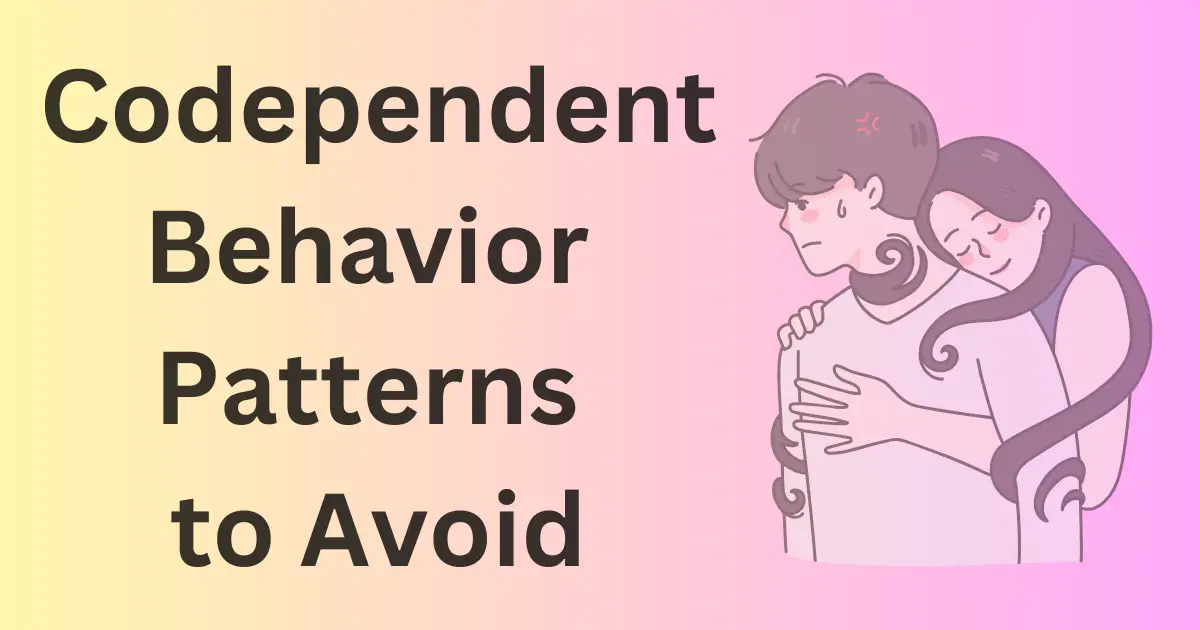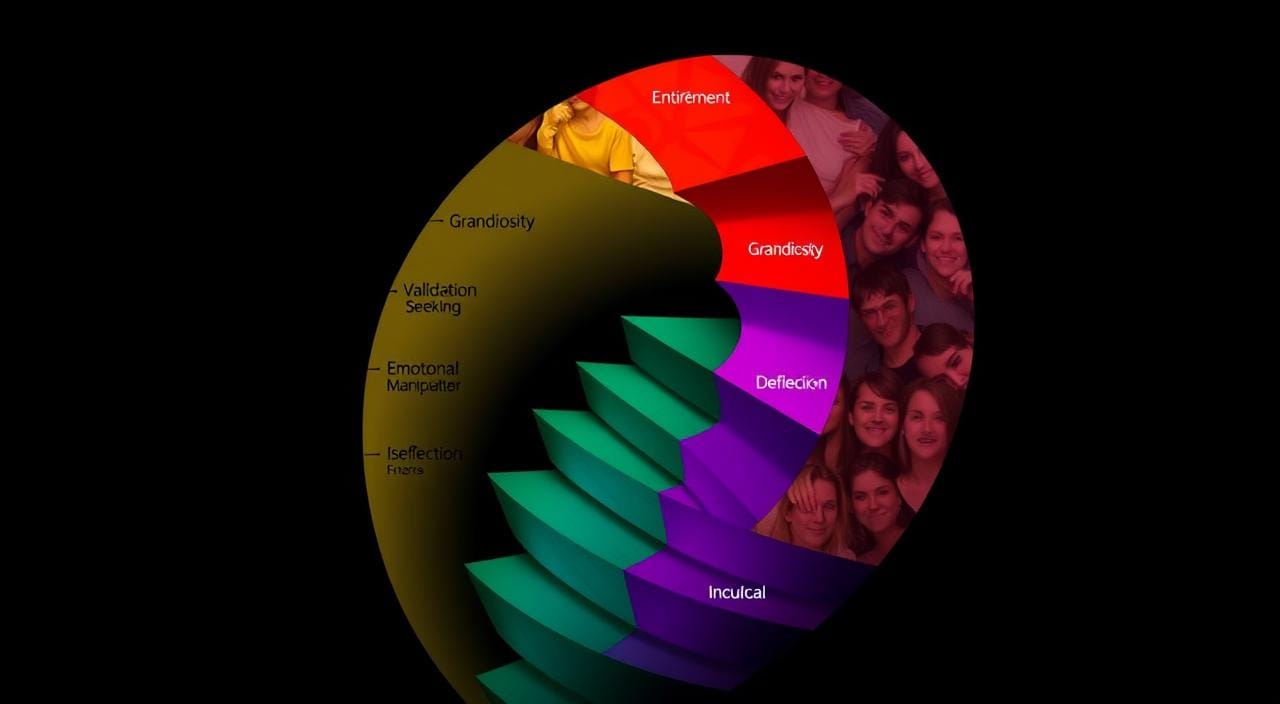Do you often find yourself sacrificing your own needs to support a partner or loved one, even when it leaves you feeling drained and unfulfilled? If so, you may be entangled in a codependent relationship. Codependency involves an unhealthy emotional and psychological reliance on others, often at the expense of one’s own well-being. So, what are codependent behavior patterns to avoid?
Codependent individuals may struggle with setting boundaries, communicating effectively, and maintaining a strong sense of self. But the good news is that you can break free from these damaging patterns and cultivate healthier, more balanced relationships.
Key Takeaways
- Codependency typically affects spouses, parents, siblings, friends, or coworkers of those with substance abuse issues1
- Codependent behavior patterns include an exaggerated sense of responsibility for others and an extreme need for approval1
- Recognizing and addressing codependent tendencies, such as avoiding arguments or worrying about others’ opinions, is crucial for personal growth1
- Professional help, self-exploration, and developing self-reliance are key to overcoming codependency1
- Embracing one’s own feelings and needs, setting boundaries, and becoming more assertive can lead to a healthier, more fulfilling life1
Identifying Codependent Behavior
Codependent behavior patterns often revolve around a deep need for approval and validation from others2. Individuals struggling with codependency may perceive themselves as completely unselfish and dedicated to their partner’s well-being, while simultaneously lacking empathy for their own feelings and needs3. This imbalance can lead to a lack of self-identity and detrimentally impact personal relationships2.
Denial Patterns
Codependents frequently minimize, alter, or deny their true emotions, preferring to focus on the needs of others2. They may go to great lengths to maintain a sense of control, often blaming others for their problems rather than taking responsibility for their own actions3. This tendency to avoid conflict and maintain harmony can stem from childhood experiences, such as neglect or the presence of a caregiver with a personality disorder2. Denail patterns are one of most important codependent behavior patterns to avoid.
Low Self-Esteem Patterns
Codependents often struggle with low self-esteem, finding it difficult to make decisions independently and harshly judging their own thoughts, words, and actions2. They may be embarrassed to receive recognition or praise, valuing others’ approval over their own self-worth3. This lack of self-confidence can contribute to a desire for constant reassurance and a fear of abandonment, leading to an inability to maintain healthy boundaries in relationships4.
| Common Signs of Codependency | Potential Consequences |
|---|---|
| Deep need for approval from others, self-worth tied to external validation | Inability to maintain healthy relationships, difficulty seeking help for addictive behaviors |
| Excessive concern about loved ones, making decisions for others | Neglecting personal needs, tolerating abuse or harmful behavior |
| Difficulty recognizing and expressing emotions, avoiding emotional intimacy | Lack of self-identity, frustration, resentment, and stress in relationships |
“Codependency can take different forms depending on the relationship, such as excessive household responsibilities, failure to assert oneself, or sacrificing other relationships for partner approval.”4
Compliance and Control Issues
Codependent individuals often struggle with challenges related to compliance and control patterns. These behaviors can stem from a deep-seated need for approval and a fear of rejection or abandonment5.
Compliance Patterns
Compliance patterns are frequently observed in codependents, indicating a tendency to conform excessively to the desires and needs of others5. Codependents may prioritize the needs of others over their own, often at the expense of their well-being5. They may be afraid to express their beliefs, opinions, and feelings when they differ from those of their partner, and sometimes accept unwanted sexual attention in an attempt to feel loved5. Individuals struggling with codependency often adopt a martyr complex, repeatedly rescuing others to feel needed5.
Control Patterns
Codependent individuals may also exhibit controlling behaviors, attempting to convince others how to think, feel, act, or behave without allowing for differing opinions or perspectives6. Controllers manipulate outcomes through various means, including using charm, manipulation, or seduction to ensure compliance6. They are unwilling to compromise, negotiate, or cooperate unless it aligns with their own agenda or desires6. Controllers demonstrate a hyper-vigilance and compulsive independence, often lacking trust in others and believing they are the only ones capable of doing things right6. They may also use gifts, favors, or sexual attention to gain approval and acceptance, feeling that they need to be needed in order to have a relationship with others5.
Avoidance: A Core Codependent Behavior
Avoidance is a central aspect of codependent behavior. Individuals struggling with codependency often act in ways that invite others to reject, shame, or express anger toward them7. They may harshly judge what others think, say, or do, using avoidance of emotional, physical, or sexual intimacy as a means to maintain distance in their relationships7.
Codependent individuals may also turn to addictions to people, places, and things as a distraction from achieving true intimacy7. They may use indirect or evasive communication to avoid conflict or confrontation, suppressing their own feelings and needs to avoid vulnerability7. Paradoxically, they may pull people toward them but then push them away when they get too close8.
Avoidance Patterns
- Codependents often struggle with setting boundaries in relationships, fearing rejection and confrontation8.
- They may feel trapped in relationships but fear being alone more than staying unhappy8.
- Frustration and anger build up over time in codependent relationships due to a lack of reciprocation8.
- Codependents may suppress their own feelings and needs to avoid vulnerability, leading to a loss of their sense of self7.
Overcoming these avoidance patterns is a crucial step in breaking free from the cycle of codependency7. By learning to set healthy boundaries, communicate effectively, and embrace vulnerability, individuals can develop more fulfilling and balanced relationships8.
Breaking Free from Codependency
Overcoming codependency is a transformative journey that requires self-awareness, healthy boundaries, and a commitment to self-care9. To break free from the patterns of codependent behavior, we must first acknowledge the root causes, such as low self-esteem, a deep need for approval, and a tendency to prioritize others’ needs over our own9.
One of the key steps in this process is learning to identify and express our true feelings9. This self-awareness empowers us to set healthy boundaries, respecting our personal values and needs9. As we let go of the need to control and embrace vulnerability, we can build the confidence to confront our avoidance tendencies and foster more balanced and fulfilling relationships9.
Seeking professional support, such as joining a Codependents Anonymous group, can be invaluable in this journey910. These support systems offer a structured approach, like the 12-step program, to help individuals break free from codependent patterns and learn to prioritize self-care10.
Ultimately, breaking free from codependency is a process of self-discovery and personal growth9. By cultivating self-awareness, setting healthy boundaries, and prioritizing our own well-being, we can create more balanced and fulfilling relationships, leading to a greater sense of fulfillment and overall well-being9.
“The greatest gift you can give someone is your own personal development. When you work on yourself, you indirectly give to everyone around you.” – Unknown
- Develop self-awareness and identify your true feelings.
- Set healthy boundaries and respect your personal values and needs.
- Embrace vulnerability and let go of the need to control.
- Confront your avoidance tendencies and build self-confidence.
- Seek professional support and join a Codependents Anonymous group.
- Prioritize self-care and personal growth.
Remember, the journey to breaking free from codependency is not an easy one, but the rewards of a more balanced and fulfilling life are well worth the effort910.
Overcoming Denial Patterns
Recognizing and embracing our emotions is a crucial step in overcoming codependency11. As individuals with codependent tendencies, we often struggle to identify our own feelings, prioritizing the needs and emotions of others over our own12. Many of us have learned to minimize, alter, or completely deny our true thoughts and feelings, a behavior pattern developed to avoid conflict in our relationships12.
Recognizing and Embracing Feelings
One common denial pattern in codependency is perceiving ourselves as selfless and solely focused on others’ well-being, neglecting our own emotional needs12. This skewed perspective can lead to a lack of empathy for others’ feelings, as we project our own negative traits onto them12. Learning to recognize and embrace our emotions, rather than suppressing or denying them, is a crucial step in breaking free from codependency.
Setting Healthy Boundaries
Establishing and maintaining healthy boundaries is also essential for those recovering from codependency11. We must learn to express what is and is not acceptable to us, and follow through with consequences when our partner treats us in an unacceptable manner11. Practicing assertive communication, using “I” statements to clearly convey our thoughts, feelings, and needs, can help us set these essential boundaries11.
Through recognizing and embracing our emotions, as well as setting and enforcing healthy boundaries, we can begin to overcome the denial patterns that have kept us trapped in codependent relationships. This self-awareness and self-care are essential for reclaiming our sense of identity and building healthier, more fulfilling connections.
Building Self-Esteem and Confidence
Recovering from codependency is a journey towards building self-esteem and confidence13. Codependents in recovery learn to trust their decision-making abilities, accept themselves as they are, and value their own opinions and feelings over the need for external approval13. They engage in self-care activities and learn new skills to further boost their self-worth and sense of identity13.
Codependents in recovery recognize themselves as equal to others and are able to establish and uphold healthy priorities and boundaries in their lives13. This process of self-acceptance and self-trust is crucial for breaking free from the cycles of codependent behavior13. By prioritizing their own needs and well-being, codependents can cultivate a strong sense of self-esteem and confidence that empowers them to create fulfilling, balanced relationships13.
Building self-esteem and self-acceptance is a key aspect of overcoming codependency.13 This involves acknowledging one’s worth, setting healthy boundaries, and learning to trust one’s own judgment and emotional responses13. It’s a transformative process that enables codependents to become more self-reliant and resilient, ultimately leading to healthier, more fulfilling relationships13.
“The most powerful relationship you will ever have is the relationship with yourself.” – Steve Maraboli
By focusing on self-care, personal growth, and developing a strong sense of self-worth, codependents can break free from the patterns of low self-esteem and build the confidence needed to establish and maintain healthy, balanced relationships13. This empowering journey of self-discovery and self-acceptance is a crucial step in the recovery process13.
Fostering Healthy Compliance
In our journey towards recovery from codependency, we learn to be loyal to ourselves and our own safety. We leave situations that are unsafe or inconsistent with our goals, remaining rooted in our personal values, even if others disagree or become angry14. When asked to participate in others’ plans, we consider our own interests and feelings, and we respect our opinions and feelings, expressing them appropriately15.
Developing healthy compliance means honoring our personal values and needs, rather than prioritizing the needs of others at the expense of our own well-being14. This shift in mindset allows us to establish boundaries, communicate our needs effectively, and engage in relationships that foster mutual respect and growth15.
Self-care practices like maintaining a balanced diet, consistent sleep, and positive self-talk are essential tools for coping with stress and building resilience in codependent relationships16. By prioritizing our own well-being, we demonstrate assertiveness and respect for our personal values, which in turn strengthens our ability to navigate challenging situations and foster healthy compliance14.
Ultimately, fostering healthy compliance is a crucial step in our recovery from codependency. It empowers us to honor our needs, stand firm in our personal values, and engage in relationships that support our growth and overall well-being16. This process requires ongoing self-awareness, self-care, and a commitment to assertiveness – all of which are vital for breaking free from the patterns of codependency and building a fulfilling, independent life.
Letting Go of Control
Recovering from codependency involves a fundamental shift in our approach to relationships – letting go of the need to control others. As we progress in our codependency recovery, we recognize that, with rare exceptions, other adults are fully capable of managing their own lives17. We accept the thoughts, choices, and feelings of our partner, even if they differ from our own preferences.
Trusting in others’ abilities is a hallmark of a healthy codependent-free dynamic. We no longer feel the urge to offer unsolicited advice or assistance, confident that our partner can handle their own affairs17. This trust allows us to step back, let go of control, and focus on our own personal growth and well-being.
Codependency often stems from a lack of trust in ourselves and others17. By embracing the idea that our partner is responsible for their own decisions, we can cultivate a more balanced and fulfilling relationship. This shift in perspective empowers us to relinquish the burdens of control and open ourselves up to the possibilities of genuine connection and mutual respect.
“Letting go of control is not about abandoning our partner or becoming indifferent. It’s about recognizing their inherent capabilities and having faith in their ability to navigate their own path.” – Codependency Recovery Expert
As we continue our journey of codependency recovery, we must constantly remind ourselves that our partner’s choices and actions are not a reflection of our worth or competence17. By trusting in their capabilities, we free ourselves from the shackles of control and pave the way for a more authentic, fulfilling, and balanced relationship1718.
Confronting Avoidance Tendencies
Overcoming codependency requires us to confront our avoidance tendencies head-on. As individuals with avoidant codependent traits, we often experienced a deficiency in emotional support during our formative years, leading us to develop self-sufficiency as a coping mechanism19. Our introverted nature, self-reliance, and strong desire for autonomy have increased our susceptibility to this behavior pattern19.
Embracing Vulnerability and Intimacy
A key aspect of our recovery is embracing vulnerability and intimacy. We must learn to let go of our fear of dependency, which has been fueled by past disappointments or insufficient emotional support19. Emotional expression has been a challenge for us, as we tend to conceal our feelings, even from ourselves, hindering our ability to articulate our personal needs19.
By confronting our avoidant tendencies, we can begin to develop more fulfilling relationships. We can engage in emotional, physical, and sexual intimacy when it is healthy and appropriate, using the tools of recovery to cultivate genuine connections. This means welcoming vulnerability, trusting our feelings, and honoring our needs, while maintaining healthy boundaries19.
The journey of overcoming avoidant codependency can be challenging, but it is a crucial step towards building the meaningful relationships we crave. Seeking professional support, such as therapy, can be instrumental in helping us identify the underlying factors contributing to our avoidant behaviors and develop more effective strategies for managing our emotional challenges.19
| Codependent Behavior Patterns | Healthy Behavior Patterns |
|---|---|
| Emotional expression challenges, concealing feelings and needs | Embracing vulnerability, trusting and honoring feelings and needs |
| Avoidance of emotional intimacy, maintaining emotional detachment | Engaging in emotional, physical, and sexual intimacy when appropriate |
| Valuing self-sufficiency, hesitant to depend on others | Welcoming close relationships while maintaining healthy boundaries |
“Engaging in vulnerability and confronting negative perceptions around reliance are crucial steps in overcoming avoidant codependency and fostering more meaningful relationships.”
- Identify and confront avoidant tendencies, such as emotional suppression and fear of dependency.
- Embrace vulnerability and cultivate the ability to express emotions openly and authentically.
- Develop healthy relational boundaries while fostering intimate connections with trusted individuals.
- Seek professional support, such as therapy, to address the underlying factors contributing to avoidant codependent behaviors.
Codependent Behavior Patterns to Avoid
Recognizing and addressing codependent behavior patterns is the first step towards developing healthier, more balanced relationships. Codependency is characterized by an excessive emotional or psychological reliance on a partner, often someone who is controlling and requires support due to substance use and addiction20. This behavior can involve compromising one’s own wants and needs to support a loved one experiencing addiction20.
Some key codependent behavior patterns to be aware of include denial patterns, low self-esteem patterns, compliance patterns, control patterns, and avoidance patterns21. Individuals struggling with codependency may have difficulty identifying and expressing their true feelings, seeking external approval, and setting healthy boundaries with others21.
- Denial patterns: Denying true emotions, perceiving oneself as unselfish, and lacking empathy for others’ needs21.
- Low self-esteem patterns: Difficulty making decisions, harsh self-judgment, and seeking external approval21.
- Compliance patterns: Loyalty to harmful situations, fear of expressing different opinions, and seeking approval through sexual attention21.
- Control patterns: Believing others cannot care for themselves, offering unsolicited advice, and demanding their needs be met by others21.
- Avoidance patterns: Inviting rejection, shaming others, and avoiding intimacy to keep distance21.
By understanding these unhealthy behavior patterns and taking steps to address them, individuals can begin the journey towards breaking free from codependency and developing more fulfilling, balanced relationships20.
| Codependent Behavior Pattern | Description | Strategies for Recovery |
|---|---|---|
| Denial | Denying true emotions, perceiving oneself as unselfish, and lacking empathy for others’ needs. | Recognize and embrace feelings, set healthy boundaries. |
| Low Self-Esteem | Difficulty making decisions, harsh self-judgment, and seeking external approval. | Trust personal decisions, emphasize progress over perfection, value self-worth. |
| Compliance | Loyalty to harmful situations, fear of expressing different opinions, and seeking approval through sexual attention. | Prioritize personal safety, stand by personal values, respect feelings and boundaries. |
| Control | Believing others cannot care for themselves, offering unsolicited advice, and demanding their needs be met by others. | Acknowledge others’ capabilities, respect boundaries, communicate authentically without manipulation. |
| Avoidance | Inviting rejection, shaming others, and avoiding intimacy to keep distance. | Foster healthy relationships, engage in appropriate intimacy, use direct communication to resolve conflicts. |
By understanding and addressing these codependent behavior patterns, individuals can take the necessary steps to break free from the cycle of codependency and develop healthier, more balanced relationships20.
“The first step towards change is awareness. The second step is acceptance.”
Seeking Professional Support
Overcoming codependency can be a challenging journey, but seeking professional support can make a significant difference. Speaking with a qualified therapist or counselor can provide invaluable guidance and support as we work to address the underlying causes of our codependent behaviors22. Participating in support groups can also be incredibly beneficial, allowing us to connect with others who understand the unique struggles of codependency and find solace in shared experiences23.
Therapists and counselors specializing in codependency recovery can help us develop effective coping strategies, set healthy boundaries, and build the self-esteem and confidence necessary to break free from codependent patterns22. Additionally, support groups offer a safe and understanding environment where we can share our stories, learn from others’ experiences, and receive the encouragement and accountability needed to make lasting changes23.
Whether it’s individual therapy or group support, seeking professional help can be a crucial step in our codependency recovery journey. By addressing the root causes of our codependent behaviors and developing healthier ways of relating to ourselves and others, we can reclaim our sense of autonomy and forge more fulfilling, balanced relationships2223.
Remember, you are not alone in this process. With the right support and guidance, we can overcome the challenges of codependency and embrace a more empowered, authentic way of living2223.
| Type of Codependent Relationship | Characteristics |
|---|---|
| Romantic | One partner may enable the other’s addictive behaviors, and there is a lack of independence and autonomy for both or one person involved23. |
| Family | Adult parent-child relationships where the parent may feel entirely responsible for the adult child’s physical well-being, while the child may feel responsible for the parent’s emotional well-being23. |
| Friendship | Codependency can affect all types of relationships, including friendships. The dynamics of caregiver and person needing care may be present23. |
By seeking professional support, whether through therapy or support groups, we can take the first steps towards breaking free from the cycle of codependency and reclaiming our autonomy and self-worth2223.
Conclusion
As we have explored throughout this article, breaking free from codependent behavior patterns is essential for cultivating healthier, more fulfilling relationships. Codependent relationships can occur between friends, family members, or romantic24, and often involve emotional or physical abuse24. By recognizing the signs of codependency, such as constant worry about a loved one’s welfare, denial of unhealthy relationship dynamics, and a tendency to shield others from the consequences of their actions25, we can take the necessary steps to break free and establish more balanced, interdependent relationships.
Through self-awareness, setting healthy boundaries, and prioritizing self-care25, we can overcome the challenges of codependency and cultivate a stronger sense of self-worth that is not solely dependent on the opinions of others25. With the support of professional counselors and a commitment to personal growth2425, we can embrace vulnerability, confront avoidance tendencies, and foster healthier compliance patterns that respect our own values and needs.
By understanding and addressing the root causes of codependency, which may include past abuse, addiction issues, or chronic mental health conditions in our family24, we can break free from these limiting patterns and build the foundation for more authentic, empowered relationships. The journey may require time and effort24, but the rewards of living a life free from codependency are well worth the investment.
FAQ
What is codependent behavior?
Codependent behavior involves excessive emotional or psychological reliance on a partner, often one who is controlling and requires support due to substance use or addiction. Codependent individuals frequently compromise their own wants and needs to support their loved one.
What are some common codependent behavior patterns?
Common codependent behaviors include keeping quiet to avoid arguments, volunteering to sacrifice personal desires for their partner’s, feeling rejected when their partner does things without them, and being unable to say “no.”
How do codependents often perceive themselves and their relationships?
Codependents may perceive themselves as completely unselfish and dedicated to others, while lacking empathy for the feelings and needs of their partner. They tend to have low self-esteem, difficulty making decisions, and a strong need for others’ approval.
What are some control and compliance issues associated with codependency?
Codependent individuals often try to convince their partner what to think, do, or feel, and use manipulation tactics such as charm, blame, and shame to control the situation. They may also compromise their own values and integrity to avoid rejection or anger from their partner.
How does avoidance play a role in codependent behavior?
Avoidance is a core codependent behavior, with codependents often acting in ways that invite others to reject, shame, or express anger toward them. They may use addictions and evasive communication to avoid conflict or intimacy.
What are the key steps to breaking free from codependency?
Breaking free from codependency involves developing self-awareness, setting healthy boundaries, building self-esteem, fostering healthy compliance, and confronting avoidance tendencies. Seeking professional support can also be incredibly helpful.
Source Links
- Co-Dependency – https://www.mhanational.org/co-dependency
- Are You Codependent? Here Are the Key Signs of Codependency – https://psychcentral.com/lib/symptoms-signs-of-codependency
- PDF – https://coda.org/wp-content/uploads/2018/09/Patterns-Characteristics-2011.pdf
- Codependency: Signs of a Codependent Relationship – https://www.helpguide.org/relationships/social-connection/codependency
- Understanding Reasons For Codependency – https://www.northstarbehavioralhealthmn.com/resources/reasons-that-people-may-become-codependent
- What is a Functioning Addict or Alcoholic? – https://www.lovecoachheidi.com/2021/01/05/the-controlling-attachment-personality-pattern-controlling-codependent/
- Avoidance is a Character Trait of Codependency – https://cottonwooddetucson.com/avoidance-is-character-trait-of/
- Boundaries and the Dance of the Codependent – https://www.psychologytoday.com/us/blog/addiction-and-recovery/201908/boundaries-and-the-dance-of-the-codependent
- How I broke free from codependency — and learned the meaning of loving relationships – https://www.npr.org/2024/08/30/g-s1-20058/signs-of-codependency-how-to-overcome-unhealthy-relationships
- How to Fix an Addicted and Codependent Relationship – https://willingway.com/fix-addicted-codependent-marriage/
- Codependency: What Are The Signs & How To Overcome It – https://positivepsychology.com/codependency-definition-signs-worksheets/
- Codependency – Denial Patterns – https://www.inclusivetherapists.com/blog/codependency-denial-patterns
- How to Stop Being Codependent: 10 Helpful Tips — Talkspace – https://www.talkspace.com/blog/how-to-stop-being-codependent/
- Healing from Codependency: Understanding and Changing Coping Skills – Start My Wellness, Ferndale, MI – https://startmywellness.com/2024/09/healing-from-codependency/
- 10 Healthy Steps to Fix a Codependent Relationship – https://www.marriage.com/advice/relationship/steps-to-fix-codependent-relationship/
- Therapy for Codependency | Charlie Health – https://www.charliehealth.com/post/therapy-for-codependency
- How to Stop Being Codependent – https://www.verywellmind.com/what-s-the-best-codependency-treatment-5070487
- Co-Dependency: An Issue of Control by Monica A. Frank, Ph.D. – https://www.excelatlife.com/articles/codependency.htm
- What is Avoidant Codependency? – https://theonlinetherapist.blog/what-is-avoidant-codependency/
- How to Not Be Codependent: 8 Tips | Psych Central – https://psychcentral.com/relationships/codependency-in-relationships
- Patterns of Recovery – CoDA.org – https://coda.org/meeting-materials/patterns-of-recovery/
- How to Stop Being Codependent | Two Chairs – https://www.twochairs.com/blog/how-to-stop-being-codependent
- Signs of Codependency – https://www.webmd.com/mental-health/signs-codependency
- Codependent relationships: Signs, examples, and more – https://www.medicalnewstoday.com/articles/319873
- Can’t Stop Protecting Others From Their Emotions? You’re Codependent. – https://melwithpals.medium.com/codependency-in-relationships-32fd8e05ed55







